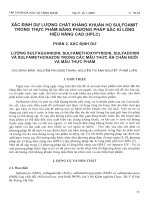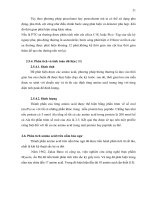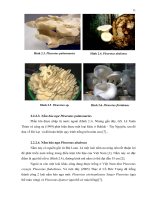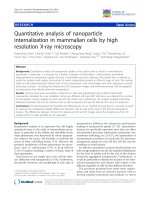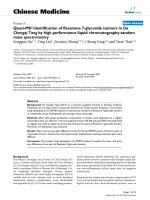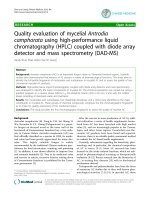studying histamine in seafood products by high performance liquid chromatography
Bạn đang xem bản rút gọn của tài liệu. Xem và tải ngay bản đầy đủ của tài liệu tại đây (329.41 KB, 34 trang )
MINISTRY OF EDUCATION & TRAINING
CAN THO UNIVERSITY
BIOTECHNOLOGY RESEARCH & DEVELOPMENT INSTITUTE
SUMMARY
BACHELOR OF SCIENCE THESIS
THE ADVANCED PROGRAM IN BIOTECHNOLOGY
STUDYING HISTAMINE IN SEAFOOD PRODUCTS
BY HIGH PERFORMANCE LIQUID
CHROMATOGRAPHY
SIZE 14-15
SUPERVISORS
STUDENT
Msc. DO TAN KHANG
LE ANH VU
Student code: 3082568
Session: 34 (2008-2013)
Can Tho, 2013
APPROVAL
SUPERVISORS
STUDENT
Msc. DO TAN KHANG
LE ANH VU
Can Tho, May 6, 2013
PRESIDENT OF EXAMINATION COMMITTEE
CONTENTS
Contents
Abstract
1. Introduction
2. Materials and methods
2.1 Materials
2.2 Methods
2.2.1. Optimization of histamine extracted solvent
2.2.2. Comparison of dansylation procedure and
benzoylation procedure in histamine analysis
in fish products.
2.2.3. Changes in histamine and microbial analyses in
tuna muscle by time and temperature
2.2.4. Study the histamine content in some samples of
seafood products
2.2.5. Statistical analysis
3. Results and dicussion
3.1 Optimization of histamine extracted solvent
3.2. Comparison of dansylation procedure and benzoylation
procedure in histamine analysis in fish products.
3.3. Changes in histamine and microbial analyses in tuna
muscle by time and temperature
3.4. Study the histamine content in some samples of
seafood products
4. Conclusions and Suggestion
4.1 Conclusions
4.2 Suggestion
References
i
i
ii
1
3
3
3
3
6
6
7
8
9
9
11
15
21
25
25
25
26
ABSTRACT
The study was undertaken to asses the effect of different
solvents in histamine analysis in seafoods. The results showed
that histamine in seafood samples was efficiently extracted with
perchloric acid 0.6M and trichloroacetic acid 6%. Moreover, the
commonly applied HPLC method to determine biogenic amines in
seafoods after dansylation was compared with an alternative
benzoylation procedure. Results showed a significant difference
in analysis efficiency among these two procedures for histamine
quantitation in tuna samples. The effects of storage time and
temperature at 0, 4oC on the development of histamine and
microbial in tuna were also studied. Tuna stored at 4oC results in
higher histamine level than tuna stored at 0oC. Sample stored at
0oC contained potentially toxic histamine concentrations (49.1
mg/kg after 11 days of storage), whereas when stored at 4oC, the
sample contained highly toxic histamine concentrations (161.29
mg/kg after 7 days of storage). An increase overtime of microbial
population was observed in all samples tested. Bacteria counts
increased from 4.54 log10 cfu/g to 5.88 log10 cfu/g in the samples
stored at 0°C, while for the samples stored at 4°C, an increase
was shown dramatically in counts from 4.54 log10 cfu/g to 8.88
log10 cfu/g. The histamine levels in some common seafoods were
also reported.
Keywords: HPLC, histamine, seafoods, extracted solvents,
temperature storage.
ii
1. INTRODUCTION
Currently histamine poisoning is one of the most common
threats to the health of consumers. Histamine poisoning occurs
after consuming seafoods containing high level of either
histamine or other biogenic amines. This foodborne intoxication
was originally called “scombroid poisoning” because it was
primarily associated with the consumption of fishes belonging to
Scombridae and Scomberesocidae families such as tuna,
mackerel, bonito, bluefish, and the like. These species contain
high levels of free histidine in their muscle that is decarboxylased
to histamine. When the conditions for the development of bacteria
are favorable (for example when the fish are kept in improper
temperatures), decarboxylase enzyme produced by the bacteria
will metabolize histidine to histamine. Other biogenic amines
produced during the development of bacteria may increase the
toxicity of histamine. The toxicity of histamine depends on the
ability of individuals to metabolize normal dietary intakes of
histamine. In some places of the world, histamine poisoning
accounted for the largest proportion of cases of poisoning
associated with fish and fish products (FAO/WHO, 2012). In
Vietnam, histamine poisoning often occurs and the fish usually
associated with these cases are tuna and mackerel (Ministry of
Fisheries, 2003).
Normally, after catching, fish has very low levels of
histamine, but this amount increases with the decomposition of
fish. Thus, histamine has also been used as an indicator to assess
the quality of the fish. US Food and Drug Administration
(USFDA, 2012) has set this histamine level at 50 mg/kg, above
1
which it is considered a potential health hazard. Considering the
importance of histamine in fish and fish products for legal,
toxicological, and quality purposes, it is essential to have accurate
analytical methods. Histamine in different foods, including fish
and fish products, have traditionally been determined by means of
standard chromatographic techniques such as thin layer
chromatography, gas chromatography, capillary electrophoresis,
flow
injection
analysis,
and
high
performance
liquid
chromatography (HPLC).
Histamine has a very important role in the food industry. In
recent years, many studies appear to study on histamine due to
large potential applications of this amine in the assessment of
quality seafood and seafood products. In addition, high levels of
histamine in seafood is also a health hazard for consumers.For
these reason, the thesis "Studying histamine in seafood products
by high performance liquid chromatography" has been carried
out.
Thesis objectives:
- Selecting the appropriate solvent for extraction process
and analysis procedure to determine histamine in seafoods by
high performance liquid chromatography.
- Studying the development of histamine in seafood over
time and storage temperature.
- Quantification of histamine content in some common
seafoods.
2
2. MATERIALS AND METHODS
2.1 Materials
- Seafood products were purchased in supermarkets in Can
Tho City.
- Reagents: Methanol, ethanol, perchloric acid (PCA),
tricholoro acetic acid (TCA), NaOH, H3PO4, dansyl chloride,
benzoyl chloride, HCl, histamine dihydrochloride, KH2PO4…
2.2. Methods
2.2.1. Optimization of histamine extracting process
- Preparation of samples: Fresh tuna (Thunnus albacares) was
preserved at 4oC for 1 week before analysis to make sure there
was large amount of histamine in tuna samples.
- Extraction of Histamine:
• Extraction using 0.6M perchloric acid (PCA): Extraction
was carried out following the method of Cseinati and Forgacs
(1999). A 10 g sample was homogenized with 20 ml 0.6M PCA
for 10 min. The homogenate was centrifuged at 7000 rpm for 10
min at 4°C, after which the supernatant was made up to 50 ml
with 0.6M PCA, filtered and stored at 0°C until use.
• Extraction using trichloroacetic acid 6%: Samples
extraction were done according to the method of Yung-Hsiang et
al. (2001). A 5 g sample was homogenized with 20 ml
trichloroacetic acid (TCA) 6% for 10 min. The homogenates were
centrifuged (10.000 g, 10 min, 4oC) and filtered. The filtrates were
then placed in volumetric flasks, and TCA was added to a final
volume of 20 ml and stored at 0°C until use.
3
• Extraction using methanol (99%): A modified method of
Lin et al. (1976) was used for the process of methanol extraction.
A 10g sample was homogenized with 50 ml methanol then
transferred to a volumetric flask, after which it was immersed in a
water bath at 60ºC for 15 min. The sample was cooled and then
centrifuged at 7000 rpm for 10 min at 4oC. The supernatant was
decanted, filtered and stored at 0°C until use.
- Determination of Histamine:
Histamine determination by benzoylation procedure:
Derivation of
extracted solutions
using benzoyl
chloride: The benzoyl derivatives of all samples were prepared
according to a method of Hwang et al. (1997). One milliliter of
2M sodium hydroxide and 10 µl of benzoyl chloride were added
sequentially to 2 ml of samples extracted solution.The resulting
solution was vortex, mixed and allowed to stand at 70oC for 20
min. Benzoylation was stopped by cooling the test tubes in an ice
bath for 30 min, and the mixed solution was extracted with 3ml of
diethylether. After centrifugation at 3000 rpm, the supernatant
was filtered through a 0.45 µm filter.
Separation of Histamine with HPLC: Histamine in test
samples were determined with a Hitachi liquid chromatograph
(Hitachi, Tokyo, Japan), consisting of a Model L-6200 pump, a
Rheodyne Model 7125 syringe loading sample injector, a Model
L-4000 UV-Vis detector (set at 254 nm), and a Model D-2500
Chromato-integrator. A Lichrospher 100RP-18 reversed-phase
column (125x4.6 mm, E. Merck, Damstadt, Germany) was used
for separation. The gradient elution program began with 50:50
(v/v) methanol:water at a flow rate of 0.8 ml/min for the first 0.5
4
min, followed by a linear increase to 85:15 methanol:water
(0.8ml/min) during the next 6.5 min. The methanol:water mixture
was held constant at 85:15 (0.8ml/min) for 5 min and then
decreased to 50:50 (0.8ml/min) during the next 2 min.
Histamine determination by dansylation procedure:
Derivation of extracted solutions using dansyl chloride:
Derivation was carried out following the method of Earola et al.
(1993). A 1ml sample extract was made alkaline by adding 200 µl
of 2N NaOH. A 300 µl saturated sodium bicarbonate and 2 ml
Dns-Cl was added to the alkaline extract. The reaction mixture
was transferred to a 40°C incubator for 45 min. Residual Dns-Cl
was removed by adding 100 µl ammonia. After centrifugation for
30 min at 2500 rpm, the supernatant was filtered through a 0.45
µm filter.
Separation of Histamine with HPLC: Histamine in test
samples were determined with a Shimadzu Prominence HPLC
apparatus (Shimadzu, Kyoto, Japan) equipped with a SPD-M20A
diode array detector (set at 254 nm) and two binary gradient
pumps (Shimadzu LC-10AT), auto sampler (SIL 20AC), column
oven (CTO-20AC), and a communication bus module (CBM20A) with valve unit FCV-11AL was used. The column was a
reverse-phase, Spherisorb 5 Si C18 pH-St, 250x4.6 mm
(Phenomenex, Macclesfield, Cheshire, UK). The mobile phase
was 95:5 (v/v) acetonitrile : water, delivered at a flow rate of 1.0
ml/min.
- Indicator for Assessment: Histamine concentration (mg/kg).
5
2.2.2. Comparison of dansylation procedure and benzoylation
procedure in histamine analysis in fish products
- Preparation of samples: Fresh tuna (Thunnus albacares) was
preserved at 4oC and taken at the appropriate times (zero, 1, 2, 3,
4 and 7 days during storage procedure) to make sure there was a
wide range of amount of histamine in tuna samples.
- Extraction of Histamine: Histamine in fish samples was
extracted by using optimum solvent derived from previous
experiment (2.2.1).
- Determination of Histamine: Histamine was determined by
using benzoylation and dansylation procedure – as described in
2.2.1.
- Indicator for Assessment: Histamine concentration (mg/kg).
2.2.3. Changes in histamine and microbial analyses in tuna
muscle by time and temperature
- Preparation of samples: Fresh tuna (Thunnus albacares) was
preserved at 4oC and 0°C. Samples were taken at the appropriate
times (Table 2) and stored at -20°C to minimise bacterial activity
that could influence the results prior to analysis. For all samples,
the histamine and microbiological analysis were assayed
collectively to optimise efficiency and to limit possible day-today variability of analyses.
Table 2: Sample taken times of tuna stored at 4oC and 0oC.
Temperature
Sample Taken Times
st
4oC
Zero
1
2nd
3rd
4th
7th
day
day
day
day
day
nd
0oC
Zero
th
th
2
4
7
day
day
day
6
th
9
11th
day
day
- Determination of Histamine: Histamine was determined by
using optimum histamine analysis procedure, which derived in
experiment 2.2.2.
- Indicator for Assessment: Histamine concentration (mg/kg).
- Microbial Analysis: The total viable count (TVC) test was
done according to the method of Guinn et al., (1999).
- Indicator for Assessment: Microbial population (log10 cfu/g).
2.2.4 Study the histamine content in some samples of seafood
products
- Preparation of Samples: Seven seafood samples were
purchased from local supermarkets in Can Tho City, descriptions
of each sample are given in Table 3.
Table 3: Description of seafood samples.
Samples
Fresh tuna
Producer/Provider
Expired day
Co.op Mart supermarket
Fresh amberjack
Metro supermarket
Fresh mackerel
Metro supermarket
Canned mackerel Co.op Mart supermarket
11/2014
Canned tuna
Co.op Mart supermarket
8/2015
Dried scomber
Vinatext supermarker
9/2013
Dried shirmp
Vinatext supermarker
11/2013
- Determination of Histamine: Histamine was determined by
using optimum histamine analysis procedure, which derived in
experiment 2.2.2.
- Indicator for Assessment: Histamine concentration (mg/kg).
7
2.2.5. Statistical analysis methods
The experiment was conducted in triplicates. The results were
reported as mean values ± standard deviation. The ANOVA test
was used for data analysis. The differences between the mean
values were considered significant when p<0.05. All data were
analysed using Statgraphic Centurion XV statistical package for
windows
(Statgraphics Centurion XV, Manugistics,
Rockville, USA, 2009).
8
Inc.,
3. RESULTS AND DISCUSSIONS
3.1 Optimization of histamine extracting process
Complete and selective extraction of target analytes from
complex food samples is of great importance in food analysis.
Solid samples are most frequently extracted with acidic solvents
which also act as deproteinisation agent during the liquid solid
extraction. Because of the high content of fat in fish samples,
extraction solvents that can remove fat or protein are frequently
selected for achieving high extraction efficiency. In this study,
perchloric acid (0.6M), trichloroacetic acid (6%, m/v), methanol
(99%) was tested as extraction solvents for the samples. Results
revealed that histamine concentrations of different levels were
obtained after the extraction of samples with different solvents
(Figure 4).
9
Figure 4: Mean of histamine concentrations in tuna samples
extracted by using Met - methanol; PCA - perchloric acid
(0.6M) and TCA - trichloroacetic acid (6%).
As shown, the highest histamine concentration was from 0.6M
perchloric acid for samples analysed by dansylation procedure.
The samples extracted by trichloroacetic acid 6% and analysed by
benzoylation procedure resulted in higher yield of histamine
concentrations as compared to the samples extracted in all the
extract medium. These results coincide with those of BenGriggrey et al. (2001), who suggested perchloric acid and
trichloroacetic acid are more effective than methanol, acetonitrile
and acetone in extracting histamine in fish products. RuizCapillas and Moral (2001) also reported that PCA and TCA are
10
highly efective biogenic amine extractors for fish and fish
products because of their efect on protein precipitation. Since
most of the biogenic amines present in fish are in bound form, the
histamine concentration was low when extracted by methanol
(Shalaby et al., 1996). In this study, histamine concentrations
obtained in the tuna fish was quite high in the acid fraction,
suggesting that histamine in fish are acid solube. Because
perchloric acid and trichloroacetic acid provided good peak shape
and effective separation, it was selected as the optimized
extraction solutions in the following experiments. The suitable
acid for extraction of histamine from fish samples and analysed
by dansylation procedure was 0.6M perchloric acid, while
trichloroacetic acid 6% was suitable acid for extraction histamine
from fish samples analysed by benzoylation.
3.2. Comparison of dansylation procedure and benzoylation
procedure in histamine analysis in fish products
Amongst the available analytical techniques, HPLC is by far
the most frequently used to separate and quantify histamine. Since
histamine present in the food samples neither show an adequate
absorption, nor exhibit significant fluorescence, derivatisation has
to be performed in order to increase the sensitivity needed for a
subsequent UV, VIS or fluorescence detection (Onal, 2007). In
this work the amines were determined by HPLC using two
procedures – dansylation procedure and benzoylation procedure –
based on pre-column derivatisation. In both methods, the
reversed-phase column was used. Typical chromatograms of
dansyl chloride and benzoyl chloride derivatives of the standard
and of the extract of sample are shown in Figure 5. As shown,
11
histamine are well separated in the nearly 3 min runtime for
benzoyl procedure, where as this seperation time was 5 min for
dansyl procedure. The peaks of histamine were satisfactorily
resolved with good peak resolution, sharpness, and symmetry,
and are consistent with previous report (Hwang et al., 1997).
However, the histamine levels determined on six test samples
revealed the significant difference in analysis efficency between
two procedures (Figure 6). In general the histamine values
analysed by benzoylation procedure were higher than the
histamine levels determined by dansylation procedure (5 of 6 test
samples). The histamine values determined by benzoylation
procedure that had lower histamine values from dansylation
procedure was 52.51 (mg/kg) on the third test. The dansylation
procedure result was 52.96 (mg/kg) for this test. However, this
difference was not statistically significant.
12
Figure 5: Typical chromatograms of the histamine standard
and samples. (A), (C) Histamine standard (1 µg/ml); (B), (D)
tuna sample at day 7 of storage time. (A) and (B):
chromatography derived by benzoylation procedure; (C) and
(D): chromatography derived by dansylation procedure.
Figure 6: Mean of histamine concentrations in tuna samples
determined by dansylation procedure and benzoylation
procedure.
13
The results of the experiment clearly represented that benzoyl
procedure was more accurate than dansylation procedure in
histamine quantitation in fish. This is related to the fact that
benzoyl chloride forms stable compounds after reaction with both
primary and secondary amino groups and the products are more
stable than those formed using dansyl chloride. Moreover, the
long derivatisation time is also an evident drawback of
dansylation procedure, as it contributed to decrease the stable of
flouresence compounds. Beside of that, ammonia has to be used
after the derivatisation in order to remove an excess of the dansyl
reagent. Without this step, the by-products such as dansylamide
(Dns-NH2), dansyl sulphonic acid (Dns-OH) and dansyl
hydrazine (Dns-N2H3) most likely appear in the chromatogram
(De Mey et al., 2011) and the excess of dansyl chloride may
coelute with histamine. Unfortunately, an addition of 100 µl
concentrated ammonia and incubation for 30 min at room
temperature, as suggested by Earola et al. (1993), could not
totally remove the excess of dansyl chloride. As a result, low
amounts of the by-products can still be detected in the
chromatogram and the peak of histamine does not remain
unaffected.
In contrast to the dansylation procedure, benzoylation is less
frequently used for the determination of biogenic amines in fish
and fish products. However, fast benzoylation gives an
opportunity to reduce the analysis time. From the literature it
comes out that the benzoyl derivatisation used to be performed at
the temperatures ranging from room temperature to 70oC. At the
room temperature, the derivatisation needs an overnight
14
incubation, while at the increased temperatures the incubation
time can range between 15 (Krause et al., 1995) and 30 min only
(Chen et al., 2003). In most cases, an incubation period of 20 min
at 70oC was recommended (Romero et al., 2000). In that way, the
highest available yields of the studied analytes were obtained and
as the excess peak of the benzoyl reagent was separated from the
analytes, no problems were encountered with quantification
thereof. In contrast to dansylation (which shows severe
decomposition of dansylated amines at the temperatures higher
than 65oC), have mentioned that at higher temperatures the peak
ascribed to the excess of benzoyl reagent decreased, without the
loss of the peak areas of the analytes. Another advantage of using
benzoyl chloride is the simple way to stop the derivatisation
reaction. While an addition of irritating ammonia is necessary to
remove an excess of dansyl chloride, an easy cooling step, for
example, an ice bath for 30 min, is sufficient to stop the
benzoylation reaction.
Since benzoylation procedure provided better results as well as
faster and easier to conduct than dansylation procedure, it was
selected as the main procedure in the following experiments.
3.3. Changes in histamine and microbial analyses in tuna
muscle by time and temperature
The amount of histamine produced by the fish is strongly
influenced by temperature, time, storage conditions and fish
spieces (Lehane and Olley, 1999). This experiment was designed
to investigate the changes of histamine and microbial population
in tuna in two different storage temperature (0oC and 4oC).
15
- Effect of storage time and temperature on histamine level
The average of histamine concentrations of tuna during the
time – temperature storage procedure are presented in Figures 7 –
8. As shown, in tuna samples stored at 4oC, the increases of
histamine varied from as low as 36.93 mg/kg to as high as more
than 161.29 mg/kg. The histamine concentrations showed
significant difference (p<0.05) in relation to the storage time. A
significant increase in the histamine value is shown until 7th day
which was above FDA standard on the 3rd day (>50 mg/kg). In
tuna samples stored at 0oC, the results revealed a steady in
histamine levels during storage procedure, although it was not as
dramatic as at 4oC. The obtained results also showed a significant
difference (p<0.05) between the mean concentration of histamine
during the storage procedure, except for histamine concentration
on the 11th day. However, histamine does not exceed the safe
limits (50 mg/kg) at the end of the life of the experiment.
16
Figure 7: Mean of histamine concentrations in tuna samples
stored at 4oC by day of storage.
Figure 8: Mean of histamine concentrations in tuna samples
stored at 0oC by day of storage.
According to the result, the storage temperature was one of the
most important factor in histamine formation. Time and
17
temperature have also been reported as the key factors in
controlling histamine development, as these factors influence the
growths of histamine-producing bacteria and the formation of
their histidine decarboxylase (FDA, 2001). The samples stored at
0oC showed little increase in histamine, while samples stored at
4oC presented toxic histamine levels. Haaland et al. (1990)
showed the relationship between the formation of free amino
acids and amines in mackerel stored at 0oC and 4oC. The contents
of several amino acids decreased when fish were stored at 4oC
with the resultant formation of phenylethylamine, tyramine,
putrescine, histamine and cadaverine. However, no obvious
changes were reported in fish stored at 0oC. Wendakoon et al.
(1990) reported a similar result with little histamine formed in
mackerel during iced storage, but high level of histamine were
found at high concentrations at 8oC. Histamine concentrations
similar to those observed in the present study have been reported
by Guizani et al. (2005) in yellowfin tuna. The histamine
concentration in yellowfin tuna stored at 4oC was 150 mg/kg after
8 days of storage, and in this study it was 161.29 mg/kg after 7
days of storage. These results coincide with those of Kim et al.
(1999), who detected low concentrations of histamine (80mg/kg)
in albacore loins stored at 0oC for 18days. Lopez-Sabater et al.
(1996) detected histamine in large tuna fish pieces from the 4th
day of storage at 8oC, measuring concentrations 425 mg/kg after 6
days of storage at 8oC, but no histamine was detected in large
tunafish pieces after 12 days at 0oC. Frank and Yoshinaga (1987)
reported histamine concentrations of 3.8 mg/kg, 5.6mg/kg, and
169 mg/kg in skipjack tuna loins stored at 0oC, 4oC, and 10oC,
18
respectively, after 12–14 days of storage, which are lower than
our measurements obtained under similar conditions; however,
the initial histamine concentration measured in the loins by Frank
and Yoshinaga was only 1.1 mg/kg, while in this study the
concentration ranged from 27 to 37 mg/kg.
- Effect of storage time and temperature on microbiological
population
Counts of total microbial on tuna samples stored at 4oC as
related to storage time are summarized in Figure 9. At the start of
the incubation, total microbial count was low (4.54 log10 cfu/g).
There was a steady increase over the period of storage to 8.88
log10 cfu/g. This count was comparable with the concentrations of
histamine formed. As revealed by Kim et al. (1999), the number
of bacteria are indirectly related to the histamine production
because its ability to provide the histidine decarboxylase. Tuna
samples stored at 0oC also showed increases in total aerobic
counts although the extent of increase was not as dramatic as at
4oC. Apparently, the slow increase in bacterial numbers at this
temperature (Figure 10) contributed to the slow increases of
histamine concentration in these samples.
19
Figure 9: Mean of total viable count in tuna samples stored at
4oC by day of storage.
Figure 10: Mean of total viable count in tuna samples stored
at 0oC by day of storage.
This study reveals that even at these temperatures, as the
storage period increases, there are relative changes in the
microbial composition that has direct effect on the histamine
value of the fish. Freezing of fish at 0°C creates an unfavourable
environmental condition for the growth and survival of the
microorganisms found on this fish, thereby reducing histamine
formation, while freezing at 4°C temperature allows for the
20
proliferation of the microorganisms, thereby increasing histamine
formation. The freeze process appears to reduce the bacterial cell
numbers or causes sublethal injuries to bacterial cells causing
poor histamine production. According to Kim et al. (2002), the
growth of histamine producing bacteria can be controlled with
cold temperatures (2-4oC) but histamine formation can be
controlled only in frozen storage. Baranowski et al. (1990)
observed that the duration of freezing of fish is an important
factor for histamine formation during storage of mahi-mahi fish.
Ben-Gigirey et al. (1998) reported that the survival of bacteria
involved in biogenic amine formation is poor at freezing
temperatures. Recently, Dalgaard et al. (2006) evaluated the
biogenic amine formation and microbial spoilage in fresh and
chilled garfish, concluding that histamine formation depends
strongly on previous freezing of the fish, which probably kills
freeze-sensitive bacteria like Photobacterium spp.or Vibrio spp.
When Staruszkiewicz et al. (2004) studied the changes in selected
biogenic amines in mahi-mahi and tuna held in freezer, they
observed that histidine decarboxylase activity was retained in
some frozen fish samples and could result in further increases in
histamine.
21

